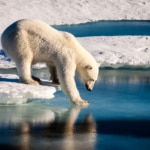Viruses and climate change: how the two threats converge
After the simultaneous paralysis of society and numerous economies around the globe resulting from efforts to contain the COVID-19 pandemic, opinions on the relationship between the virus and climate change — how the pandemic is causing a global drop of pollution levels — have been manifold. In the longer term backdrop there is an additional school of thought that is associating global warming with the emergence of new viruses that could represent future threats akin to that of SARS-CoV-2. How is climate change affecting the virulence, emergence, and re-emergence of viral threats?

Long before the the theory of infectious diseases was established in the the mid-19th century, humans already sensed that climatic conditions were related to epidemics. The custom of Roman aristocrats retiring to mountain homes in the summertime to avoid malaria, for example, proves the point. In addition to each respective climate’s naturally fluctuating temperatures, human activity has caused average temperatures to rise 1°C from pre-industrial levels, a trend that could reach up to 1.5°C before 2050, according to the Intergovernmental Panel on Climate Change.
Climate Change as a Risk Factor
As a result of climate change, sudden temperature changes and more frequent extreme weather events such as floods, hurricanes, and droughts, would be an ideal breeding ground conducive to virus modification and the emergence of infectious diseases. The key to understanding this relationship, as summarized by the European Society of Clinical Microbiology and Infectious Diseases, is to recognize that alterations in average temperatures, humidity levels, vegetation quality, and the ensuing large-scale movement of animals inevitably results in changes in arthropod distribution patterns. Arthropods (which include insects) are uniquely successful at transmitting disease.
The World Health Organization has been resolute in its warnings about the risks of climate change, which, together with other factors such as globalization and demographic and social changes, may influence the occurrence of infectious diseases. Scientists have already demonstrated, for example, that the extent to which there is a rise in the world’s average temperature, there is an increase in the range of activity of malaria-transmitting mosquitoes.
Furthermore, other factors that are related to climate change, like pollution and the deterioration of air quality, make us more susceptible to infectious respiratory diseases. This was borne out by the 2002 SARS virus epidemic in China, during which patients from regions with higher levels of air pollution were twice as likely to die after being infected compared to those in regions with better air quality.
In 2009, the United States Agency for International Development launched PREDICT, a project aimed at detecting the emergence of zoonotic viruses — those viruses that pass from animals to humans — because they can be sources of potential pandemics. During its first decade of activity, PREDICT discovered at least 931 different viruses and provided assistance to 60 countries in order to bolster global defense against the threat of zoonotic diseases. Unfortunately, the program was canceled only a few weeks before the the novel coronavirus, SARS-CoV-2, emerged, as explained by the scientific journal The Lancet.
For its part, the WHO stays vigilant for these microscopic adversaries. As the WHO explains, there is a three-pronged approach to the research linking climatic conditions and the transmission of infectious diseases. On one hand, it focuses on studying evidence from the most recent infectious diseases and the variations in the climate; it also analyzes those emerging viral infections for the long term, while at the same time developing predictive models to estimate the future impact of these diseases in different climate change scenarios.
The Role of Insects, Animals and Humans in Spreading Viruses
As a report published by the WHO explains, climate change can mainly influence the spread of viral diseases on four fronts.
Insects are one of the most important. So much so that an article published in 2018 in the journal Nature indicated that 30 percent of all emerging diseases from the previous decade had been transmitted by vectors (the overarching term for mosquitoes, flies, birds, fleas, lice, etc.). As they adapt to climate change, Insects are changing their life cycle and their areas of influence. As an example, Lyme Disease is an infection transmitted by a type of tick that, according to scientists at Yale University, is expanding significantly to the north in Canada and will see a 213 percent increase to the habitat it needs for its survival.
The destruction of pristine ecosystems, the razing of forests and other human impacts on the natural environment could increase the risk that other viruses will transfer from animals (also wild ones) to people. According to a study published in Nature, it is in fact degraded habitats that breed more viruses that can infect humans. Researchers at the United States Agency for International Development have determined that nearly 75 percent of all new diseases, emerging or re-emerging, affecting humans at the beginning of the 21st century are zoonotic. In the same vein, the Centers for Disease Control and Prevention (CDC) in the United States estimate that three out of every four new or emerging diseases originate with animals, a fact that has been confirmed with respect to the origin of COVID-19, as published by a study in Nature.